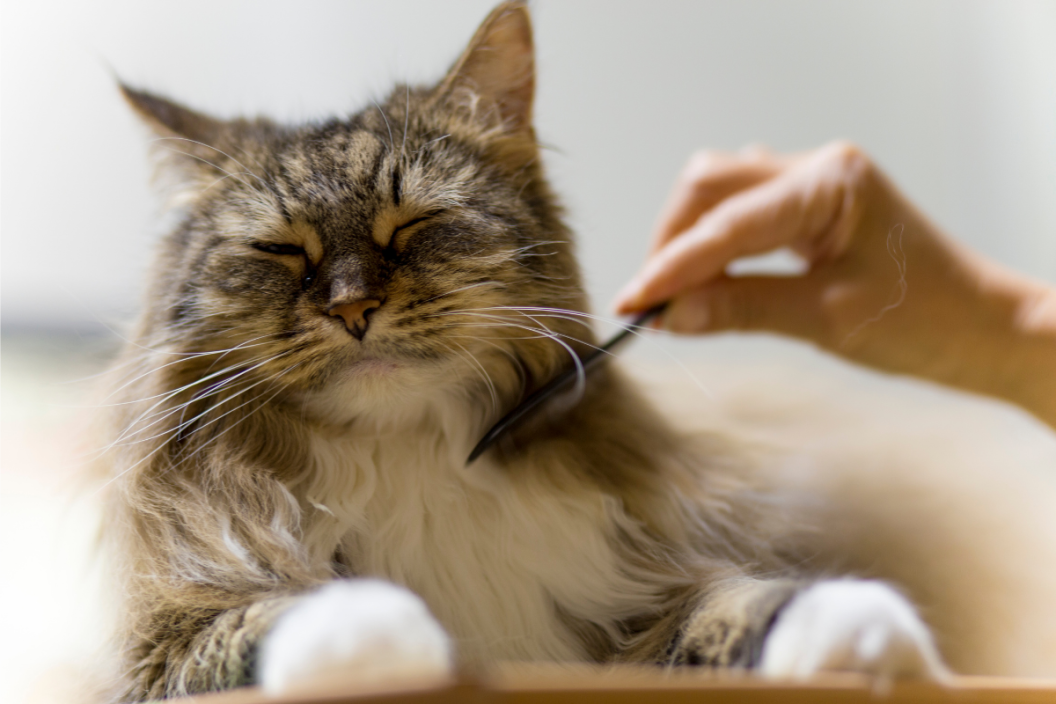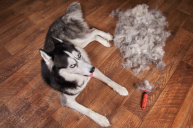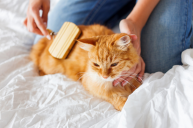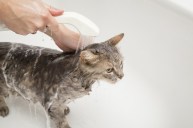Did you know that cats shed in the fall? It's completely normal, and you can help your feline friend prep for winter.
As most pet owners know, a cat's coat can shed year-round; they will lose a little fur here and a little fur there. But, cats also go through shedding cycles. Usually, a cat's undercoat is shed twice a year—once around September and then again in February. But the amount of shedding can vary by cat breed and age. How much a cat sheds can also be affected by where they live. Indoor cats are more prone to shedding little by little throughout the year, while outdoor cats have a slightly different shedding process. Here's a look at how to support your cat's fall shed.
Grooming Indoor Cats
https://www.instagram.com/p/CRROU_eMW-h/
Shedding is a normal part of a cat's life, but it does not need to be a painful process. Most indoor cats will slowly shed their fur throughout the year, but when it comes to the fall, cats will shed their undercoat in preparation for the next season. In the fall, cats are preparing to grow their winter coat. Indoor cats are used to artificial light and an even temperature, so they may shed less than their outdoor counterparts. But they will still shed, so keep those lint rollers handy!
A cat's fur coat goes through a life cycle as it grows. Healthy fur reaches the end of its life and dies. Then the loose hair falls out. Shedding is the dead hair coming off your cat's skin and making room for new hair growth. A healthy cat will go through this cycle continuously. On the other hand, sick cats will not shed at all.
It does not matter if you have a short-haired cat or a long-haired cat. They will both go through this process if they are healthy kitties. The biggest difference will be the amount of hair they lose and how often you have brushing sessions. The only cat owners who are exempt from this process are those who own wire-haired breed or hairless breeds, like Sphynx cats.
Cats like Maine Coons and Persians have very long fur and will need to be brushed daily. Even their faces need brushing! Even though cats are known for grooming themselves, brushing these long-haired breeds daily will help reduce their fall shed.
Outdoor Cat Grooming Needs
RELATED: Does Your Cat Fuss During Bath Time? Check Out Waterless Shampoo for Cats
Outdoor cats shed in the fall to make room for heavy winter undercoats. When you brush your cat, you can feel the difference between the two fur types. When it gets closer to winter, I always notice that our indoor-outdoor kitty, Bandit, looks like she is bulking up. It is usually in line with her fall, which almost seems counterintuitive. But, it is her heavy undercoat coming in.
Outdoor cats can be prone to getting more tangles or matting in their fur, especially if they roam in areas with lots of burs and prickly leaves. So during the times of the year when they are shedding, you may want to see a groomer to make sure their hair loss does not become overwhelming or cause a matted mess. If your cat gets matted, they may end up with bald spots and can even have skin infections and other medical problems pop up.
Dr. Sellers, DVM and veterinary advisor to Cat Person, told Pets by Wide Open Media that regular grooming will help with the process. She suggests taking a flea comb or a narrow tooth comb to your pet's fur to help pull out the dead hair from the undercoat. If you just use a brush, you will only remove the top layer of fur. Your cat will end up ingesting this fur and will get hairballs, and no one wants to have to deal with hairballs!
Though, if your cat's fall shed does lead to an uptick in furballs, grab some pumpkin and add one tablespoon to your cat's diet twice a week, along with a fur-ball lubricant. After grooming, a wet paper towel will also help you trap any loose hairs that may create furballs down the line.
Supplements To Keep Cat's Coats Healthy
https://www.instagram.com/p/CG7yfeJngJi/
A balanced diet will keep your cat's coat healthy and help prevent skin conditions. However, if cats have a poor diet or are allergic to something in their cat food, they may struggle with skin irritation or excessive shedding. If this occurs, your cat may end up with bald spots or itchy hot spots on their skin, which will lead to a pretty grumpy kitty.
Supplements like fish oils and fatty acids will help keep your feline friend's skin and fur healthy. However, consult your vet if they have a balanced diet but have flakey dry skin or more hair loss than normal. Your cat likely is having an allergic reaction to something in their environment, and your vet will be able to help you pinpoint what is going on.
How do you handle your cat's fall shed? Tell us on our Wide Open Pets Facebook page.




